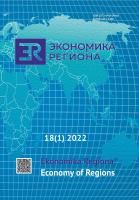Прогнозирование миграционных процессов методами цифровой демографии
Digital Demography Methods for Forecasting Migration Processes
Author(s): Andrey Vladimirovich SmirnovSubject(s): Economy, Demography and human biology, Migration Studies, ICT Information and Communications Technologies, Socio-Economic Research
Published by: Институт экономики Уральского отделения Российской академии наук
Keywords: digital demography; migration; digital society; virtual population; big data; digital footprint; digitalisation; social networks; graphs; demography; Russia;
Summary/Abstract: The nature and intensity of migration processes are constantly changing. Demographic statistics are not suitable for obtaining up-to-date information and making timely decisions in the field of demographic and social policy. Thus, digital demography is becoming increasingly important, as this area of population research uses new methods and data sources resulting from the Internet expansion and the digitalisation of society. Using digital demography methods and emerging data sources, the study aims to identify current migration trends in Russia at the municipal level. The duality of the object (real and virtual population) and methods (demographic and data science methods) of digital demography is demonstrated. Digital data sources for studying migration and relevant processing methods were considered. Further, it was proposed to assess migration flows by examining social network information and graphs of migration routes. The analysis of data obtained from the “Virtual population of Russia” project for 2356 urban and municipal regions revealed the features of intermunicipal migration and the centres of migration attraction in the country. An indicator for assessing the potential of future migrations based on the graphs of migration routes was presented. The analysis results show that balanced spatial development of Russia requires the stimulation of human capital development in local centres characterised by high migration potential. These include regional capitals, “second” cities in terms of population, and some research and industrial centres. The study findings can be used to consider demographic processes at the municipal level and elaborate strategic documents in the field of regional spatial development. Further digitalisation and the implementation of digital economy projects will lead to the accumulation of population data at the national level. Therefore, future research should focus on improving digital demography methods for studying and forecasting demographic processes.
Journal: Экономика региона
- Issue Year: 18/2022
- Issue No: 1
- Page Range: 133-145
- Page Count: 13
- Language: Russian

